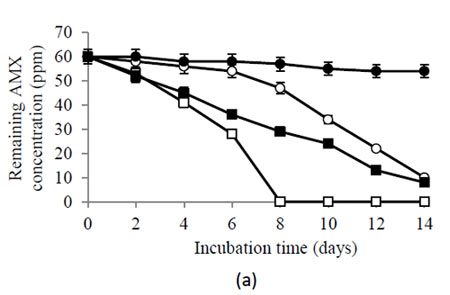Evaluation of Amoxicillin and Sulfonamide Removal by Bacillus cereus, Enterobacter ludwigii and Enterobacter sp.
Main Article Content
Abstract
Most antibiotics are prone to release to the environment due to improper usage. The present study reports the biodegradation Amoxicillin (AMX) and Sulfonamide (SDI) by Bacillus cereus, Enterobacter ludwigii and Enterobacter sp. strains. These strains were previously reported to be crude oil degraders. Different concentrations of AMX and SDI (0 - 420 ppm) were used to detect Minimum Inhibition Concentration (MIC) by a 96 well plate method. Removal of the antibiotic was studied by introducing 0.5 mL of starved bacterial suspensions into sterilized freshwater containing each antibiotic at 60 ppm and 120 ppm accordingly, followed by incubation at 28 oC with shaking at 100 rpm. The 0.5 mL sample aliquots were removed at 2-day intervals for 14 days and analyzed by HPLC. The MIC values for SDI and AMX were recorded as 240 ppm, 420 ppm for B. cereus, 120 ppm, 360 ppm for E. ludwigii and 180 ppm and 300 ppm for Enterobacter sp., respectively. B. cereus strain completely removed AMX and 80% of SDI after 14 days of incubation. E. ludwigii showed 75% degradation for AMX and 60% for SDI, whilst, Enterobacter sp. degraded 80% of AMX and 70% of SDI, respectively. Therefore, these bacterial strains could be used as a useful bioremediation tool in the removal of antibiotics, contamination in the environment.
Article Details
Published articles are under the copyright of the Environment and Natural Resources Journal effective when the article is accepted for publication thus granting Environment and Natural Resources Journal all rights for the work so that both parties may be protected from the consequences of unauthorized use. Partially or totally publication of an article elsewhere is possible only after the consent from the editors.

